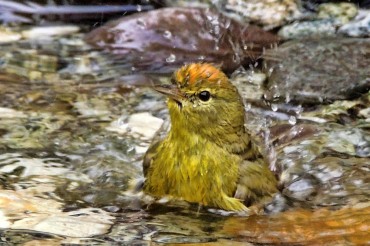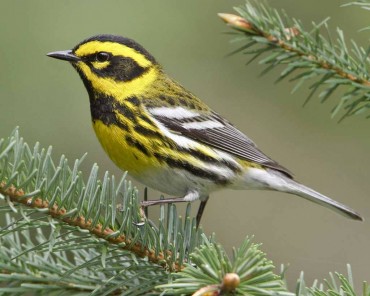
Warbler watching in West Sound country can’t compete with what the eastern portion of North America enjoys, but we do have several special warbler species. Not only do warblers move into the Northwest with spring’s arrival, some have been brightening the winter landscape.
Winter visits from the Townsend’s warbler appear more frequent than they did in past decades. Their willingness to dine at the growing number of feeders could be the reason. This handsome bird, with the black-and-white coloring splashed with patches of yellow, stands out from the more drab winter residents. As the weather warms and spring advances, this bird’s colors will deepen and grow even more brilliant.
The Townsend’s species nest in large, forested areas at all elevations but they prefer Douglas fir forests. Upon reaching their breeding grounds, they sing and call nonstop. Their song is repeated over and over as they forage through the spring foliage: “Weazy, weazy, seesee.”
Another colorful warbler that can be seen in small numbers during the winter months is the yellow-rumped. There are two forms of this species and at one time they were considered two separate birds — Audubon’s warbler and Myrtle’s warbler.
The Audubon’s has a yellow throat and the Myrtle’s has a white throat. Sometimes both forms will travel in mixed flocks. This warbler wears blue-gray and white plumage with patches of yellow. There is yellow on its crown, on its shoulders and on its rump, in addition to the yellow on the Audubon’s throat.

Not all warblers have songs that deserve the “warbler” description but this species does. A flock visiting your yard or foraging along a riverbank will communicate with a two-part trill that rises and falls: “Seet, seet, seet, seet.” Their persistent, almost nonstop calling makes it possible to find the flock and identify them.
Orange-crowned warblers sometimes show up during the winter months but this warbler is one of the “official” spring signs in the birdwatching world. They are often heard before they are seen. Their less colorful, greenish plumage allows them to blend perfectly into the trees and bushes.
They don’t stand out the way other warblers do. Most of the time, the crown of the male is hidden in the feathers on the top of his head. When a female shows up, he will flash those orange feathers and make them stand up for the lady.
Birdbaths are good places to see this bird’s crown. When orange-crowns bathe, they ruffle their crown feathers along with the rest of their body’s plumage. The voice of the orange-crowned warbler is described as a “colorless trill.” It may not sound musical, but it is “music to the ear” of West Sound birders. That sound confirms spring’s arrival.
When it comes to extra-special warblers, there is one that nests in this part of the country but it isn’t easy to see. The hermit warbler lives up to its name. It doesn’t stop at lowland feeders on its way to spring nesting grounds.
Even when it does reach those places, it keeps a low profile. In addition to being difficult to see, the hermit often poses the question: “Is that a true (or pure) hermit warbler?” This bird will hybridize with the Townsend’s warbler in those regions where the ranges of the two overlap.
One of those areas is the foothills on the western side of Hood Canal. When the rhododendrons blanket the sides of Mount Walker, it’s time to look for returning hermit warblers. The picnic areas and trails on the top of this mountain make it easy to spend time enjoying the views and listening for the singing birds.
Knowing the song of the hermit warbler is the best way to know if one is active in the immediate area. It has one of the more intricate songs and is described as “three high lisping notes followed by two abrupt lower ones; sweety, sweety, sweety, chup’ chup’, or seedle, seedle, seedle, chup’ chup’.”
The abrupt endnotes are distinctive. Also distinctive is the plumage of the hermit: a black, white and yellow combination that stands out because most of the bird’s entire head (crown, face, cheeks) are yellow.
The yellow warbler is a tiny mite that arrives in the West Sound the later part of spring. Trees and bushes will be covered with colorful blossoms when this all-yellow bird breaks into song. Considering its small size, the yellow warbler appears to be all voice box.
It’s hard to believe such a loud, cheerful song can be delivered by something so small. “Tsee-tsee-tsee-tsee-titi-wee” is one description. Another says, “Weet weet weet weet tsee tsee.” Both are given rapidly. The singing male adds color to his breeding plumage in the form of reddish-brown stripes down his chest. Otherwise, like the female, he is colored in lemon-yellow that is slightly greenish on the back. No other warbler is so yellow.
These Northwest warblers that begin moving into the West Sound at this time of the year are only a sampling of the warblers we can see in this region and throughout the rest of the state. Their songs are one of spring’s most emphatic ways of announcing its arrival.
At first, they can be confusing to identify but today’s technology can address this age-old problem. When you want to hear what a bird sounds like, search for it online. Then, start listening. Any day now, that first spring warbler will sing.

























Comments